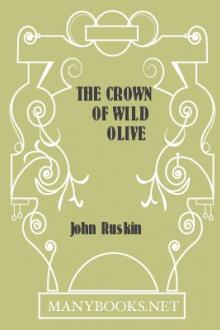The Crown of Wild Olive, John Ruskin [best ereader for graphic novels .txt] 📗

- Author: John Ruskin
- Performer: -
Book online «The Crown of Wild Olive, John Ruskin [best ereader for graphic novels .txt] 📗». Author John Ruskin
Hedging and Ditching.
Dumblane Abbey.
Morpeth.
Calais Pier.
Pembury Mill.
Little Devil's Bridge.
River Wye (not Wye and Severn).
Holy Island.
Clyde.
Lauffenbourg.
Blair Athol.
Alps from Grenoble.
Raglan. (Subject with quiet brook, trees, and castle on the right.)
If you cannot get one of these, any of the others will be serviceable, except only the twelve following, which are quite useless:—
1. Scene in Italy, with goats on a walled road, and trees above.
2. Interior of church.
3. Scene with bridge, and trees above; figures on left, one playing a pipe.
4. Scene with figure playing on tambourine.
5. Scene on Thames with high trees, and a square tower of a church seen through them.
6. Fifth Plague of Egypt.
7. Tenth Plague of Egypt.
8. Rivaulx Abbey.
9. Wye and Severn.
10. Scene with castle in centre, cows under trees on the left.
11. Martello Towers.
12. Calm.
It is very unlikely that you should meet with one of the original etchings; if you should, it will be a drawing-master in itself alone, for it is not only equivalent to a pen-and-ink drawing by Turner, but to a very careful one: only observe, the Source of Arveron, Raglan, and Dumblane were not etched by Turner; and the etchings of those three are not good for separate study, though it is deeply interesting to see how Turner, apparently provoked at the failure of the beginnings in the Arveron and Raglan, took the plates up himself, and either conquered or brought into use the bad etching by his marvellous engraving. The Dumblane was, however, well etched by Mr. Lupton, and beautifully engraved by him. The finest Turner etching is of an aqueduct with a stork standing in a mountain stream, not in the published series; and next to it, are the unpublished etchings of the Via Mala and Crowhurst. Turner seems to have been so fond of these plates that he kept retouching and finishing them, and never made up his mind to let them go. The Via Mala is certainly, in the state in which Turner left it, the finest of the whole series: its etching is, as I said, the best after that of the aqueduct. Figure 20., above, is part of another fine unpublished etching, "Windsor, from Salt Hill." Of the published etchings, the finest are the Ben Arthur, Æsacus, Cephalus, and Stone Pines, with the Girl washing at a Cistern; the three latter are the more generally instructive. Hindhead Hill, Isis, Jason, and Morpeth, are also very desirable.
[223] You will find more notice of this point in the account of Harding's tree-drawing, a little farther on.
[224] The impressions vary so much in colour that no brown can be specified.
[225] You had better get such a photograph, even if you have a Liber print as well.
[226] See the closing letter in this volume.
[227] Bogue, Fleet Street. If you are not acquainted with Harding's works (an unlikely supposition, considering their popularity), and cannot meet with the one in question, the diagrams given here will enable you to understand all that is needful for our purposes.
[228] I draw this figure (a young shoot of oak) in outline only, it being impossible to express the refinements of shade in distant foliage in a woodcut.
[229] His lithographic sketches, those, for instance, in the Park and the Forest, and his various lessons on foliage, possess greater merit than the more ambitious engravings in his "Principles and Practice of Art." There are many useful remarks, however, dispersed through this latter work.
[230] On this law you will do well, if you can get access to it, to look at the fourth chapter of the fourth volume of "Modern Painters."
[231] The student may hardly at first believe that the perspective of buildings is of little consequence: but he will find it so ultimately. See the remarks on this point in the Preface.
[232] It is a useful piece of study to dissolve some Prussian blue in water, so as to make the liquid definitely blue: fill a large white basin with the solution, and put anything you like to float on it, or lie in it; walnut shells, bits of wood, leaves of flowers, &c. Then study the effects of the reflections, and of the stems of the flowers or submerged portions of the floating objects, as they appear through the blue liquid; noting especially how, as you lower your head and look along the surface, you see the reflections clearly; and how, as you raise your head, you lose the reflections, and see the submerged stems clearly.
[233] Respecting Architectural Drawing, see the notice of the works of Prout in the Appendix.
LETTER III. ON COLOUR AND COMPOSITION.My Dear Reader:—
If you have been obedient, and have hitherto done all that I have told you, I trust it has not been without much subdued remonstrance, and some serious vexation. For I should be sorry if, when you were led by the course of your study to observe closely such things as are beautiful in colour, you had not longed to paint them, and felt considerable difficulty in complying with your restriction to the use of black, or blue, or grey. You ought to love colour, and to think nothing quite beautiful or perfect without it; and if you really do love it, for its own sake, and are not merely desirous to colour because you think painting a finer thing than drawing, there is some chance you may colour well. Nevertheless, you need not hope ever to produce anything more than pleasant helps to memory, or useful and suggestive sketches in colour, unless you mean to be wholly an artist. You may, in the time which other vocations leave at your disposal, produce finished, beautiful, and masterly drawings in light and shade. But to colour well, requires your life. It cannot be done cheaper. The difficulty of doing right is increased—not twofold nor threefold, but a thousandfold, and more—by the addition of colour to your work. For the chances are more than a thousand to one against your being right both in form and colour with a given touch: it is difficult enough to be right in form, if you attend to that only; but when you have to attend, at the same moment, to a much more subtle thing than the form, the difficulty is strangely increased—and multiplied almost to infinity by this great fact, that, while form is absolute, so that you can say at the moment you draw any line that it is either right or wrong, colour is wholly relative. Every hue throughout your work is altered by every touch that you add in other places; so that what was warm a minute ago, becomes cold when you have put a hotter colour in another place, and what was in harmony when you left it, becomes discordant as you set other colours beside it; so that every touch must be laid, not with a view to its effect at the time, but with a view to its effect in futurity, the result upon it of all that is afterwards to be done being previously considered. You may easily understand that, this being so, nothing but the devotion of life, and great genius besides, can make a colourist.
But though you cannot produce finished coloured drawings of any value, you may give yourself much pleasure, and be of great use to other people, by occasionally sketching with a view to colour only; and preserving distinct statements of certain colour facts—as that the harvest-moon at rising was of such and such a red, and surrounded by clouds of such and such a rosy grey; that the mountains at evening were in truth so deep in purple; and the waves by the boat's side were indeed of that incredible green. This only, observe, if you have an eye for colour; but you may presume that you have this, if you enjoy colour.
And, though of course you should always give as much form to your subject as your attention to its colour will admit of, remember that the whole value of what you are about depends, in a coloured sketch, on the colour merely. If the colour is wrong, everything is wrong: just as, if you are singing, and sing false notes, it does not matter how true the words are. If you sing at all, you must sing sweetly; and if you colour at all, you must colour rightly. Give up all the form, rather than the slightest part of the colour: just as, if you felt yourself in danger of a false note, you would give up the word, and sing a meaningless sound, if you felt that so you could save the note. Never mind though your houses are all tumbling down—though your clouds are mere blots, and your trees mere knobs, and your sun and moon like crooked sixpences—so only that trees, clouds, houses, and sun or moon, are of the right colours. Of course, the discipline you have gone through will enable you to hint something of form, even in the fastest sweep of the brush; but do not let the thought of form hamper you in the least, when you begin to make coloured memoranda. If you want the form of the subject, draw it in black and white. If you want its colour, take its colour, and be sure you have it, and not a spurious, treacherous, half-measured piece of mutual concession, with the colours all wrong, and the forms still anything but right. It is best to get into the habit of considering the coloured work merely as supplementary to your other studies; making your careful drawings of the subject first, and then a coloured memorandum separately, as shapeless as you like, but faithful in hue, and entirely minding its own business. This principle, however, bears chiefly on large and distant subjects; in foregrounds and near studies, the colour cannot be had without a good deal of definition of form. For if you do not map the mosses on the stones accurately, you will not have the right quantity of colour in each bit of moss pattern, and then none of the colours will look right; but it always simplifies the work much if you are clear as to your point of aim, and satisfied, when necessary, to fail of all but that.
Now, of course, if I were to enter into detail respecting colouring, which is the beginning and end of a painter's craft, I should need to make this a work in three volumes instead of three letters, and to illustrate it in the costliest way. I only hope at present to set you pleasantly and profitably to work, leaving you, within the tethering of certain leading-strings, to gather what advantages you can from the works of art of which every year brings a greater number within your reach;—and from the instruction which, every year, our rising artists will be more ready to give kindly, and better able to give wisely.
And, first, of materials. Use hard cake colours, not moist colours: grind a sufficient quantity of each on your palette every morning, keeping a separate plate, large and deep, for colours to be used in broad washes, and wash both plate and palette every evening, so as to be able always to get good and pure colour when you need it; and force yourself into cleanly and orderly habits





Comments (0)